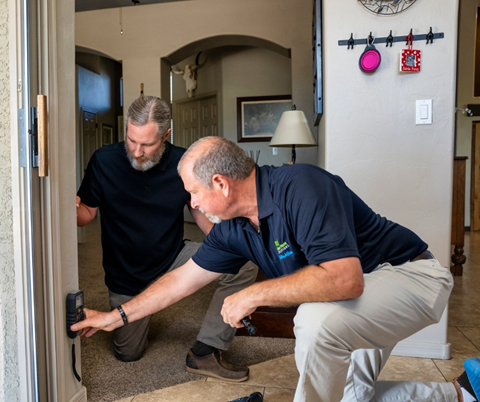Comprehensive Solutions for Your Mycotoxin testing Services Needs
Comprehensive Solutions for Your Mycotoxin testing Services Needs
Blog Article
How Mycotoxin Testing Assists Stop Contamination and Secure Food Materials

Mycotoxin testing is an essential method in the food market, offering as a frontline defense versus contamination by unsafe toxic substances created by molds. Through the application of sophisticated methods like High-Performance Fluid Chromatography (HPLC) and Fluid Chromatography-Mass Spectrometry (LC-MS), food manufacturers can precisely spot and evaluate mycotoxin degrees in agricultural products.
Comprehending Mycotoxins
Recognizing mycotoxins begins with identifying that they are poisonous second metabolites generated by certain molds, which can infect agricultural items. These metabolites are not necessary for the growth or reproduction of the fungis but can have extreme effects for animal and human health. Mycotoxins are typically found in staple crops such as corn, wheat, barley, and nuts, where they can multiply under specific problems of dampness and temperature level.
There are several kinds of mycotoxins, each created by various fungal types. Fusarium types create trichothecenes and fumonisins, both of which are associated with numerous acute and persistent wellness problems.

Dangers of Mycotoxin Contamination
The threats of mycotoxin contamination are multifaceted, posing substantial hazards to both food safety and public health and wellness. Mycotoxins, poisonous compounds produced by specific kinds of fungi, can pollute a vast array of farming items including cereals, nuts, flavors, dried fruits, and coffee. As soon as these contaminants penetrate the food supply, they can result in serious health issues such as liver damages, kidney failure, and even cancer cells. Vulnerable populations, including kids, the elderly, and immunocompromised people, are specifically in jeopardy.
Economic effects are an additional significant worry. Polluted crops can result in considerable financial losses for farmers and food manufacturers because of decreased returns and the demand for costly purification steps. Furthermore, worldwide profession can be dramatically hindered as nations enforce strict mycotoxin regulations to safeguard their populaces, resulting in denied shipments and stretched profession connections.
Environmental aspects such as environment change worsen the danger of mycotoxin contamination. Variations in temperature and humidity can develop favorable problems for fungal development, increasing the possibility of contamination occasions. Thus, understanding and alleviating these dangers are critical for making certain the security and integrity of global food supplies.
Techniques of Mycotoxin Checking
Properly recognizing mycotoxin contamination in farming products is essential for guarding public wellness and keeping food security requirements. Different approaches are used to find and evaluate mycotoxins, each offering certain advantages and restrictions.
High-Performance Liquid Chromatography (HPLC) is an extensively utilized method as a result of its high level of sensitivity and accuracy. It entails separating visit this web-site mycotoxins from other compounds in an example, allowing precise quantification. Liquid Chromatography-Mass Spectrometry (LC-MS) integrates liquid chromatography with mass spectrometry to offer thorough molecular details, making it specifically helpful for identifying numerous mycotoxins simultaneously.

Gas Chromatography-Mass Spectrometry (GC-MS) and Thin-Layer Chromatography (TENDER LOVING CARE) are additionally used, each with one-of-a-kind applications. GC-MS is efficient for unpredictable mycotoxins, while tender loving care supplies a less complex, cost-efficient choice for initial testing.
Benefits of Routine Evaluating
Routine testing for mycotoxins in farming products provides numerous advantages, substantially contributing to public health and wellness and food safety and security. By recognizing contamination early, routine testing assists avoid the distribution of harmful foods, thereby lowering the danger of mycotoxin-related ailments amongst consumers. This aggressive technique not only safeguards human health and wellness however additionally enhances the overall quality of food materials.
Various countries and regions have established strict restrictions for mycotoxin levels in food and feed. Adhering to these limitations through go right here routine testing makes certain that vendors and manufacturers meet legal standards, therefore staying clear of penalties and trade barriers.
In addition, routine mycotoxin screening can bring about considerable economic advantages. Early detection of contamination enables timely intervention, lowering prospective losses from extensive contamination. Executing routine screening procedures can additionally minimize recall prices and associated responsibilities, which can be financially ravaging.
Additionally, normal screening offers useful information that can educate far better farming techniques and storage space problems. By recognizing patterns of contamination, manufacturers can adopt preventative actions, thus decreasing get more future risks and adding to the sustainability of the food supply chain.
Executing Examining Protocols
Carrying out effective mycotoxin screening methods is important for ensuring the security and high quality of farming products. Developing a durable screening framework includes several vital steps, beginning with the recognition of prospective contamination points within the production and supply chain. This consists of pre-harvest, post-harvest, storage space, and circulation phases. Each phase needs to be looked at to identify where mycotoxin contamination is probably to occur.
Once vital control points are determined, selecting proper screening approaches is vital. Usual techniques include enzyme-linked immunosorbent assay (ELISA), high-performance liquid chromatography (HPLC), and mass spectrometry (MS) Each method has its strengths and weak points; therefore, choosing the proper one depends upon the particular mycotoxin being evaluated, the required sensitivity, and available resources.

Finally, incorporating the testing protocols into an extensive food safety administration system is a good idea. This enhances traceability and allows speedy rehabilitative actions when contamination is spotted, thereby safeguarding the integrity of the food supply chain.
Final Thought
Mycotoxin testing is necessary in stopping contamination and safeguarding food materials by allowing early detection of harmful contaminants produced by mold and mildews in farming products. Routine screening boosts brand name online reputation, financial security, and trust fund in food safety and security by minimizing contamination-related losses and preserving high standards in food production.
Mycotoxin screening is a crucial technique in the food industry, offering as a frontline protection against contamination by harmful contaminants created by molds. An integrated technique including agricultural techniques, storage space management, and normal testing can alleviate the risks linked with mycotoxin contamination, making certain food safety and security and public wellness.
The dangers of mycotoxin contamination are complex, presenting considerable threats to both food safety and security and public wellness.Normal testing for mycotoxins in agricultural items supplies many benefits, considerably adding to public health and food safety and security.Mycotoxin screening is essential in avoiding contamination and securing food products by making it possible for early detection of dangerous toxic substances produced by mold and mildews in agricultural products.
Report this page